Uni High Engineering Class Makes Wind Maze for Orpheum Museum
January 22, 2015
"It's a real-world project: they're learning about engineering by actually being engineers."
– Sharlene Denos, Uni High engineering teacher
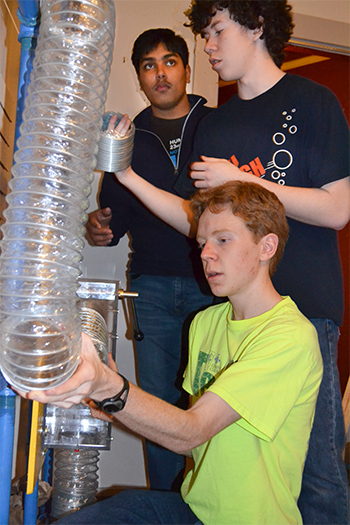
Uni High students (left to right) Shaleen Agrawal, Ben Carlton, and Ansel Higgs add a section of plastic tubing to the wind maze they're building.
This past summer, University Laboratory High School (Uni) teacher Sharlene Denos made a visit to Champaign's Orpheum Children's Science Museum to further cement the university's partnership with the museum. She told the interim director:
"I've got this new engineering class, and I'd really like them to do something that would benefit the community. We love the Orpheum; is there anything that we can design and build for you that would be useful for your museum?" The director promptly responded, "Yes, we really want an air maze."
It turns out that some group on campus had agreed to build one (and had even purchased a bunch of clear, plastic flexible tubing), but had dropped the ball. So Denos and company picked up the ball and ran with it.
Denos wrote a proposal to the Makino Foundation, which generously donated funding; plus, the school, which supported them every step of the way, also contributed to the project. MechSE's Joe Muskin, plus Cliff Gulyash and his cohorts in MechSE’s Machine Shop, donated some time and expertise.
How did the project benefit the Uni students? “First of all,” says Denos, “they’re doing something that’s going to benefit the community.”
Several students who participated on the project agreed, saying that giving back to the community made the project extremely rewarding. In fact, several had frequented the museum as kids and were delighted to be able to give back in some way.
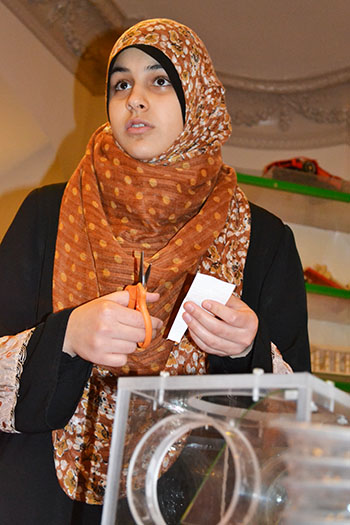
Uni student Haneen Jaber cuts plastic to use to tie the wind maze to the scaffolding.
For example, senior Haneen Hazem Jaber says, “I definitely found this project rewarding, as I got to give back to the community and especially to a museum with which I share many happy childhood memories.”
“Working to create an air maze for the Orpheum was an amazing opportunity, and it was wonderful to give back to the community in an imaginative way,” acknowledges Nafisa Syed. “I used to visit the Orpheum often as an elementary school student, and being able to contribute to the museum as a high school senior was extremely rewarding.”
Syed also loves being able to expose the youngsters to science: “It also helped me realize how much I love creating projects that help share science with others…I can’t wait to see how the museum visitors react to the exhibit!”
Darren Liu indicates that he too had patronized the museum when he was little: “The Orpheum Children’s Museum is a place that I loved going to when I was little…It felt great to give back to the place that had offered me countless hours of entertainment when I was younger while also learning a lot.”
Denos adds that another benefit for students was a sense of achievement: “It’s a tangible thing that they can point to and say, ‘I did that; I designed that; I built that!’”
Darren Liu found that sense of achievement to be particularly rewarding: “Not many teenagers get to say they contributed an entire exhibit in a museum. I’m grateful for the opportunities that I had, and I hope to be proud of the finished product! This project is another way I can leave my mark on the community, and I hope as many people can appreciate it as possible.”
The fact that a previous group—of adults, no less—had tried (and failed) to complete the project was another boost to the students’ self-confidence—if a bit intimidating at the beginning.
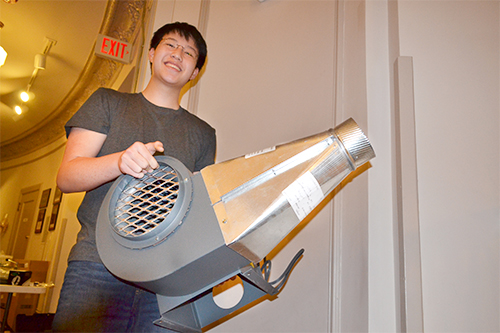
Darren Liu prepares to install the blower motor in the brightly painted box they constructed to house it.
“When we first started the project, I really wasn’t sure we’d be able to do it,” admits Liu...“I thought to myself: ‘If a group of capable adults had tried and failed, how would a disorganized group of high schoolers be able to pull this off?’”
But Liu says they learned as they went along: “In the beginning, nobody really knew what exactly to expect or even what they were doing. Over time, however, it really solidified and once we started getting materials everything came together really well.”
Another aspect of the project students liked was that it was hands-on: “This project was especially enjoyable, as it was very hands-on, even if I was initially scared to use tools like a drill and a saw,” Jaber admits. Liu agrees: “The hands-on nature of the project really appealed to me. I want to be able to continue to do things like this in the future.”
Denos also explains that they went through a lot of steps that real-world engineers go through, such as working on a team and solving problems:

A Uni student creates a housing for the blower fan.
“There have been tons of challenges that have presented themselves every step along the way that I didn’t really foresee,” admits Denos. “It’s a really interesting, difficult project. They’ve had to figure out a way to break it up into little pieces and distribute the workload, and try to figure out who was going to do what.”
For example, Syed agrees that breaking the project down into pieces was key: “We split the larger task of building an air maze into smaller ones, and created teams to handle each aspect of the air maze. I worked on the “Object Group,” and helped create objects that museum visitors could put into the maze. We went through several object designs before settling on a final prototype, and I think that collaboration played a large role in our success.”
Liu also discovered how important sharing the work load is: “One person can’t control every part, so it becomes especially important to delegate and communicate to get things done more efficiently.”
Denos also explains that they also experienced what real engineers do as they learned to problem solve…and to ask for help: “When nobody seemed to know how to do something, they had to figure out who they were going to ask.”
Syed describes how they solved problems: “Many of the problems we encountered as a group dealt with numbers: tubing measurements, fan power, object speed, and so on and so forth. We solved these problems by working together, and staying in communication with each other.”
Liu agrees that teamwork was key: “The general process for problem solving was mostly teamwork. We had enough people such that every time a problem arose or there was a need, there would be people to work on it.”
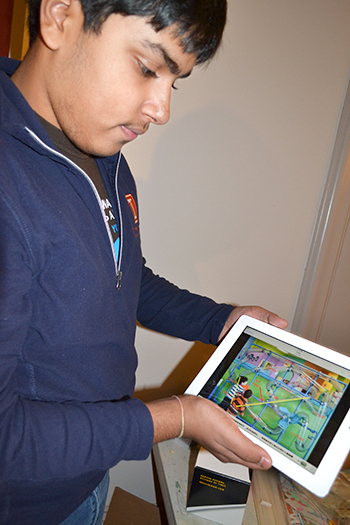
Shaleen Agrawal consults the wind maze design during the construction phase.
Jaber agrees that input from other classmates was helpful: “Luckily, I didn’t encounter any major problems with the air maze since my group’s focus was on the input box which doesn’t really rely that much on the rest of the air maze. Thus, the rough draft of the input box didn’t drastically change as much as other parts of the air maze. Generally, problems were found through testing and prototypes and were often solved by suggestions from classmates outside of my group.”
Liu describes one specific problem they encountered, then solved together: “When we were assembling the scaffolding, we realized that the threading of the pipes would make it such that both sides horizontally couldn’t be screwed in all the way. That stumped everyone for a while, until another student realized in order to get the most secure connection, one could screw one side in all the way and then screw the pipe in on the other side such that both sides are half-screwed.”
One expert the students went to for help was Clifford Gulyash, who heads up MechSE’s Machine Shop. Gulyash and his colleagues helped construct a couple of components: a control box and an input box.
“What I did with the students was enjoyable, because I let them tell me what they wanted to do. They designed this. I just asked them the appropriate questions…They set all the rules.”
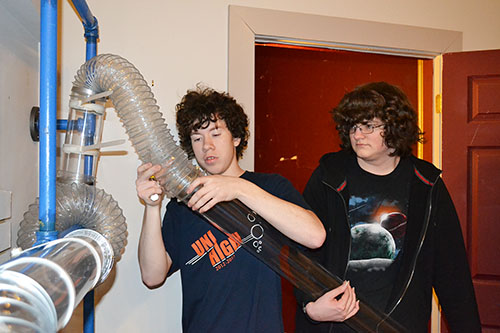
Uni High students Ben Carlton and Andrew Leigh add a section of plastic tubing to the wind maze.
Gulyash says the students met with him, they designed the two boxes, ordered the materials, then he and the other guys in the shop built them. He says they even assembled them, bolted them together, and tested them to make sure they would work. But lest they deprive the students of even the smallest learning experience, they then took them apart again and told the kids, “Here you go.”
Says Gulyash: “I let these high school students tell me what they wanted to do, and we went ahead and did it, and tried to do it in a way they would actually be involved in the assembly of it.”
What did the students learn about engineering through the project? Syed says she discovered a “new side” of engineering, and that it’s much more than “numbers, diagrams, and equations,” but there’s also the human equation.
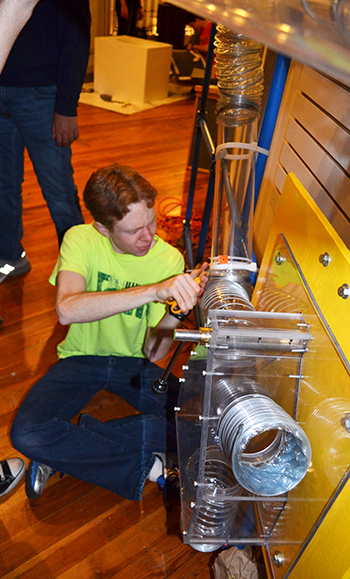
Uni High student Ansel Higgs attaches some plastic tubing to the almost completed wind maze.
“It’s a very human field driven by creativity as much as it is by mathematics. While we worked out the angles and measurements for the maze, we were also taking into account the concerns of the children, parents, and museum staff that would be interacting with the exhibit. Questions like “How would a child respond to this kind of object?” and “How can we make this exhibit engaging for a variety of age groups?” were just as important as “How much power does the fan need?” and “What diameter should the tubing be?” By thinking about such a variety of questions, I discovered the multifaceted nature of engineering.”
Of course, one important consideration in regards to the audience was safety: “These are items that are going to be used by children, so they had to be safe, smooth, no sharp edges,” says Gulyash.
The students learned another important engineering principle: engineering involves designing and testing prototypes, then making needed changes: “Through this experience I have learned that in general, major projects in engineering require many prototypes, tests, and input from other experts on the project as well as the audience the project is catering to.”
Liu hadn’t anticipated this aspect of engineering: “I always thought the engineering process would be extremely rigid with very little margin of error," he says. "Every piece would need to be thought out and thoroughly tested. Because of time constraints, we didn’t exactly get to do all that. Throughout the entire project, everything was very fluid and constantly changing, from the design to the materials.”
Gulyash sees outreach opportunities such as working with students on the wind maze project to be a great recruiting tool: “To see these high school students come down here working on this project, it is instantly clear that these people are going to be walking the halls here in no time at all…So why not help them? It's just a no-brainer.'"
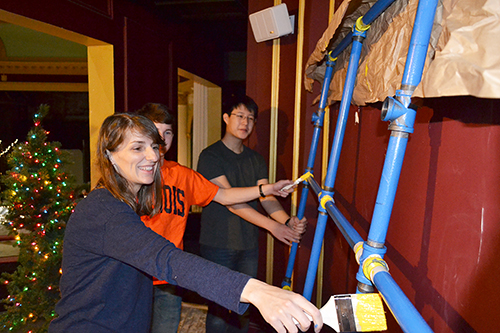 (Left to right): Sharlene Denos, Grant DeAtley, and Darren Liu paint the scaffolding for the wind maze.
(Left to right): Sharlene Denos, Grant DeAtley, and Darren Liu paint the scaffolding for the wind maze.So did the Wind Maze project impact the career choices of any of the Uni seniors?
According to Syed: “Working on this project definitely solidified my interest in STEM-based fields.” Liu says it steered him towards engineering: “This project and the entire class definitely solidified my leaning towards having an engineering career.”
Jaber says it’s definitely engineering now: “Going into this engineering class, I had already had an inclination towards majoring in engineering but I can definitely say that this class and its main focus on the air maze project have gotten me to have a deeply rooted love for engineering and to know for sure that that’s what I want to do in the future.”
Since the Wind Maze will be a permanent exhibit at the museum, Denos figures more students than this year’s engineering class will benefit from the project. She sees the Wind Maze as an opportunity for ongoing projects down the road and expects her class to permanently play a role. “Maybe even future engineering classes will add on to it. They could modify it, change it, improve it in different ways.”
For additional I-STEM articles about the Uni High, see:
- MechSE's Gaurav Bahl Promotes Outreach and Undergrad Research
- Uni Seniors Take an Initial Look at the LEGO® DNA Learning Center Set
- High Schoolers Gain Authentic Research Experience at Illinois
For additional I-STEM articles about the University's partnership with the Orpheum Children's Museum, see:
- Grand Opening of Orpheum’s Air Maze Celebrates Fluid Mechanics, Rheology
- REACT: Reaching and Educating Tomorrow's Chemists Today
- IGB's Genome Day Exposes Visitors to Genomic Research
Story and photographs by Elizabeth Innes, Communications Specialist, I-STEM Education Initiative.
More: Champaign-Urbana Community, K-12 Outreach, Orpheum, Uni High, 2015
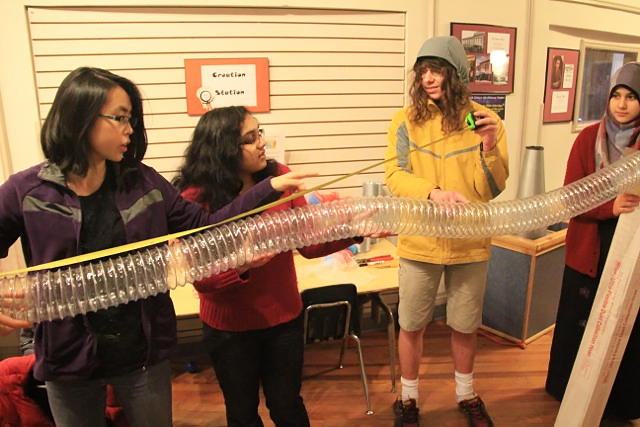
(Left to right): Chloe Yang, Nafisa Syed, Cole Petruzzi, and Haneen Jaber attach plastic tubing to the wind maze. (photo courtesy Sharlene Denos).













.jpg)
















